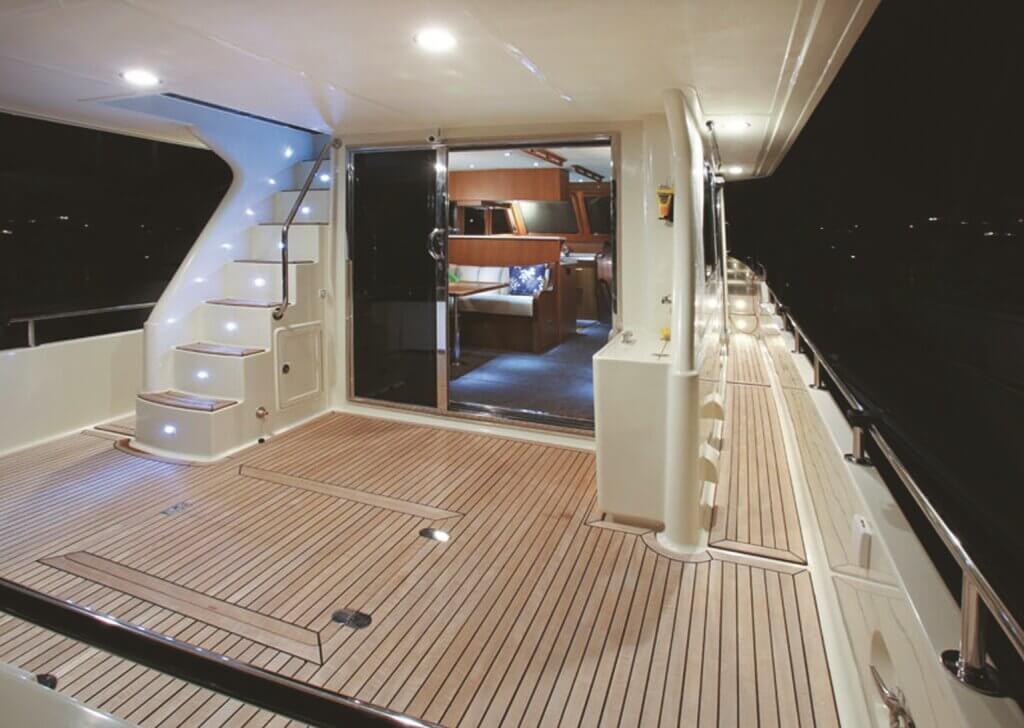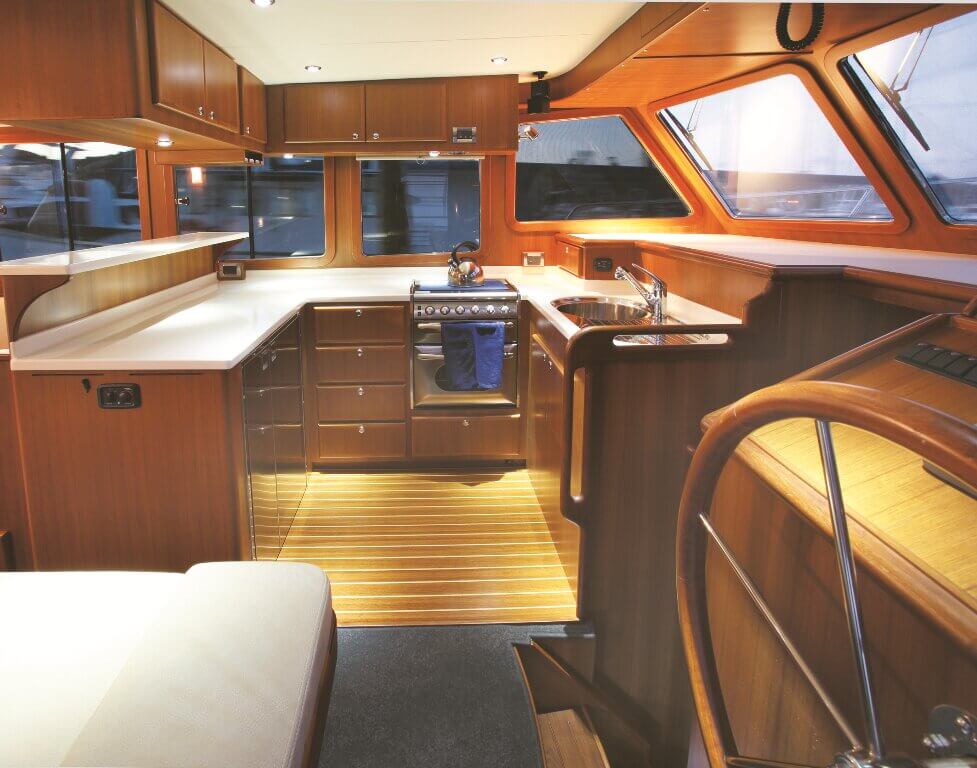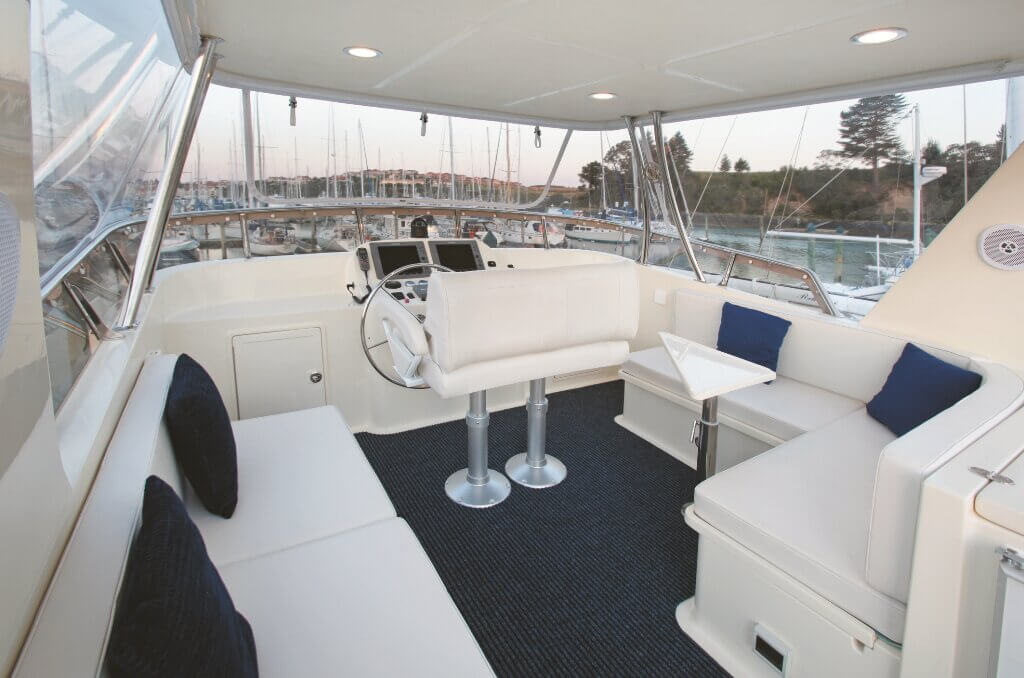Author : Barry Thompson
LOCAL FLAVOUR
In 2010 Clipper Motor Yachts released four new models. Amongst them was the Clipper 45, the smallest of the new range. The Clipper Cordova 45 has been designed both internally and externally to best suit local conditions and requirements.
What suits a European or US owner may not be the same as the wants and needs of Kiwis and Aussies. With this in mind, the Cordova 45, along with the Cordova 48, 52 (which was released in mid 2009) and 60 have been heavily influenced to make best use of local market trends and have been derived from years of experience by Clipper owners and dealers.
Since the first Clipper arrived in Australia in 1977, the range has undergone some transformation, but it wasn’t until 2010 that we really saw big changes. Although its boats are built in China, Clipper Motor Yachts is a 100% Australian owned company with a growing dealer network on both sides of the Tasman.
Libertar, the first Clipper 45 built, was sold by NZ distributor Phil Gilbert of Gilbert Marine to an Auckland based client who plans to do extensive coastal and local cruising. To date eight have been ordered, with the second Cordova 45 already berthed at its new home in Picton and the third of the line sold to a Norwegian client. Clipper’s production rate is for the Cordova 45 is one every 6-8 weeks.
There is a lot of similarity in the internal layouts of the Cordova range, with the size of each model dictating the accommodation plan. The Cordova 45 and the new Cordova 48 are essentially the same in many ways, apart from the fact that the 48 is big enough to have two cabins and two bathrooms.
The extra one metre in the 48 is in the midship forward area and the flybridge is a little longer. The Cordova 52, which is close to 16.5m overall, is big enough for three cabins and two bathrooms.

The other major difference is that all Cordova 45s to date have been powered with single engines, whereas the Cordova 48 is a twin engine boat. However twin engines are also available for the 45 should your prefer.
Power options vary, with Yanmar and Cummins the favoured brands for the 45. Libertar is powered with a single 480hp Cummins QSB engine, which gives a cruise of 10 knots and wide open speed of 14.5 knots. Twin Yanmar 315s will give you a cruise around 14 knots.
With the semi displacement hull form there are obviously some restrictions on how fast you can go and while twin engines certainly give the 45 a better top end speed, (around 19 knots) the efficiency factors at speed don’t read as good as when powered with a single engine.
When Shiloh, #2 Clipper 45, powered also by a 480hp Cummins QSB, was delivered to Picton, it averaged 9.5 knots @ 29L/h, which is very economical boating.
Clipper uses a heavy lead layered foam with perforated aluminium as sound insulation in the engine room and the result is a very quiet boat while underway. Trials in Auckland indicated 65-72 dBA in the main saloon.

The Cordova 45 is 14.80m overall so will fit comfortably into a 15m marina, whereas the Cordova 48 is slightly over the 15m maximum marina length and the Cordova 52 is going to require a berth that handles its 16.50m overall length.
Local Layout
Libertar is designed with the ‘kiwi’ layout, with seating opposite the dinette, whereas the traditional US layout has this area taken up with an entertainment centre on the starboard side.
The ‘kiwi’ layout allows for a better seating arrangement and more storage opportunities.
The starboard setee slides out and a set of squabs transforms it into another large single, plus the dinette table opposite can be modified to drop down and form yet another double accommodation area.
Port and starboard cupboard and drawer units on the aft bulkhead are just one of number of kiwi inspired additions to Libertar. There are a number of different places to mount the TV, which like all the electronics on the boat can be installed either at the factory or point of delivery.

Within reason, clients can customise the layout, but unlike a full custom boat, there are strict parameters to work within.
There are essentially three basic layouts for the Clipper 45 and they include such changes as repositioning of the galley, changing where the forward stairs are placed and upgrades to twin island berth accommodation packages.
The owners of Libertar chose to upgrade to Ultraleather which adds a really quality look to the already inviting interior. The semi gloss teak provides that old world look while appropriate lighting in all the right places offers the right mood at night.
Although the windows around the saloon are tinted, roller blinds are neatly hidden behind the pelmets when not required and give you extra privacy or sun protection when down.
Even though the saloon sole is finished in traditional teak and holly, the owners of Libertar chose to cover it with a nylon carpet, which like the blinds was designed and fitted when the boat arrived in New Zealand.


Bench Seat Helm
Fitting a large single pedestal style helm seat to the Cordova 45 would not only take a lot of space, but would also look out of style with the traditional layout, so Clipper has designed a one and a half bench seat. The front folds down so if it’s rough you can stand to drive and use it as a bolster, which is quite neat.
Under the seat is a pull-out drinks locker. There are various helms available and a lot depends on your final electronics package. The owner of Libertar feels that as he will do most of his driving from the upper helm, he has only a single Raymarine E120 screen downstairs and opted for two at the flybridge station. This is in fact complete the reverse in
Shilo, with a larger more squared off console to accommodate the twin screens. Libertar, like most trawler style boats, is complete with a sliding door alongside the helm, which gives instant access to the side bulwarks and foredeck areas – very handy if you are shortcrewed when mooring or anchoring.

The galley in the Cordova 45 is alongside the helm, which in the case of Libertar has a Corian benchtop surface, but you do have the option of granite. The galley has been altered from the original design, with the sink now placed forward in the vanity, which has given a load more bench space and is in fact bigger than the galley in the Cordova 48.
The standard boat comes with an electric induction type hob and convection microwave, but the owners went for a Serada gas oven. There’s also a stainless steel isotherm fridge/freezer under the bench, surrounded with plenty of storage drawers and cupboards. There are excellent sightlines from the helm and galley right through to the transom. The aft bulkhead is virtually all glass and coupled with the high profile saloon and wheelhouse windows the saloon is a well lit area.
While Libertar was fitted with stainless steel doors through to the cockpit, the Cordova 45 comes standard with bi-fold alloy doors. The three-section unit provides a variety of opening possibilities, depending on your needs at the time.

The cockpit and boarding area is essentially 11sqm of unencumbered space, with a 1m long boarding platform. There’s a huge lazarette beneath, with storage under the coamings, a live bait tank and a second Isotherm freezer for extra provisions when cruising long periods. To starboard is a small sink unit and opposite is the moulded stairway which leads to the flybridge.
Libertar has a solid GRP hardtop with unobtrusive stainless steel supports and all-round clears. This provides the best of both options, with protection from the sun or the weather but with the ability to let the cool wind drift past when the clears are rolled up. The aft deck looks after the dinghy stowage, complete with an Australian Davits and Cranes davit crane and there’s a neat entertainment console with a barbecue, icemaker/fridge and wet bar.
Forward, there is plenty of settee seating either side and also aft of the helm seat. Options include single or twin pedestal helm seats. The console is adaptable to suit single or twin screens and all the necessary controls are duplicated around the central console.

Shared Ensuite
Libertar has a two-bedroom, single-bathroom layout, with two singles to port and large double forward. The forward owners’ cabin has an island berth with storage under, a cedar lined wardrobe and is finished with teak timber panelling and a teak and holly sole. There is the option of wall coverings including timber battens or fabric.
This cabin shares the same ensuite with the guests and has its own access, and with the two-way lockable doors, it can be kept private. The ensuite has a large moulded shower stall with bi-fold doors and a teak floor grate, mirrored ceiling, Corian counter top and Tecma electric head.
The twin singles in the guest cabin are of a generous size, with ample walk space between and also a night stand unit. However, without the nightstand, you can have it so the berths come together to form one large double, or be kept separated when single berths are required. There is good height and volume in the cabin, due in part to the redesign of the gallery above. As in all of the boat, there is also great use of space for storage, so there is plenty of room to put away your gear.

Mature Buyers
The Clipper Cordova 45 is a boat designed for mature, well experienced owners who are at a stage in life where they appreciate the comforts a boat such as this can bring. The old saying about the pleasure is in the trip as much as the destination is aptly suited to the Clipper Cordova 45. The fact that trips take a little longer is certainly made up for by the comforts offered by the vessel.
Clipper markets the Cordova 45 in its standard form for less than $NZ1 million and it’s certainly very good buying.
TECHNICAL SPECIFICATIONS
- Boat Design Name: Clipper Cordova 45
- Boat Name: Libertar
- Year Launched: 2010
- Designer: Steve Williamson
- Interior Designer: Clipper
- Builder: Clipper Motor Yachts
- LOA: 14.80m
- Beam: 4.38m
- Draft: 1.20m
- Displacement: 16.5 tonnes (Mid Trim)
- Max Speed: 14.8 knots
- Cruise Speed: 9.5 – 10.2 knots
- Construction: GRP & coremat
- Fuel Cap: 2280 litres
- Water Cap: 1330 litres
- Engine Make: Cummins QSB @ 305hp




